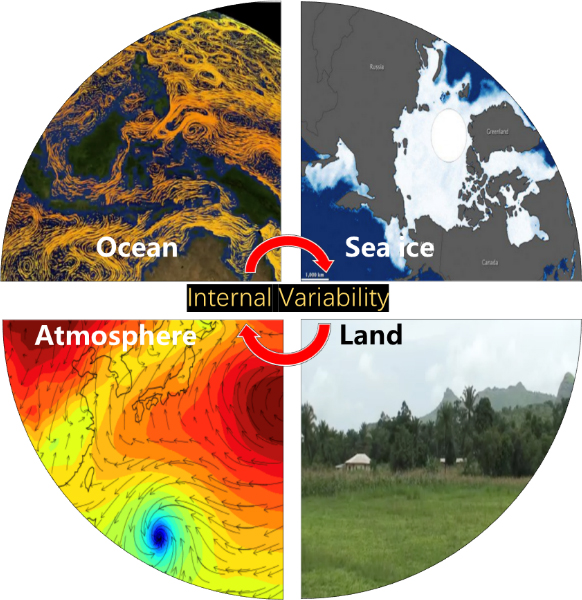中国科学院大气物理研究所大气科学和地球流体力学数值模拟国家重点实验室
State Key Laboratory of Numerical Modeling for Atmospheric Sciences and
Geophysical Fluid Dynamics (LASG)
Institute of Atmospheric Physics, Chinese Academy of Sciences
State Key Laboratory of Numerical Modeling for Atmospheric Sciences and
Geophysical Fluid Dynamics (LASG)
Institute of Atmospheric Physics, Chinese Academy of Sciences

Vol.18/No.18 December 2022
The First Set of Large Ensemble Simulations with a Global Climate System Model Reveal the Role of Internal Climate Variability

Figure 1. Internal variability generated from internal processes in the climate or Earth system and how it can impact climate change. (Image by LIN Pengfei)
Climate system models aid IV studies by providing simulations, especially when employing single-model initial-condition large ensemble simulations, which are an ensemble of simulations tied to a single climate model under a particular radiative forcing scenario. The large ensemble simulations apply perturbations, or deviations from normal input, to the initial conditions of each member to create diverging weather and climate trajectories. The ensemble sizes of large ensemble simulations are subject to computational and resource limits similar to those used in previous studies. Recently, several modeling center research groups have conducted single-model initial-condition large ensemble simulations that are now possible with rapidly increasing computer abilities.
Employing large ensemble simulations to study climate change has been a hotspot in climate research. For instance, the National Center for Atmospheric Research (NCAR) released a large ensemble simulation in 2015 that has been cited more than one thousand times. Until then, the ensemble sizes have featured no greater than 100 members and, even today, few of ensemble simulations have 100 ensemble sizes.
To study the impact of IVs on future global monsoon projections, the LASG ocean model team group from the Institute of Atmospheric Physics (IAP), Chinese Academy of Sciences (CAS) produced a super-large ensemble simulation with 110 members from their FGOALS-g3 climate system model. The full breadth of their research is available in a data description paper entitled "The Super-large Ensemble experiments of CAS FGOALS-g3" published in Advances in Atmospheric Sciences.
"The Super-large Ensemble experiments of CAS FGOALS-g3 are the first set of large ensemble simulations from a global climate system model named FGOALS-g3 developed by IAP, CAS," said lead author ZHAO Bowen. "The large ensemble simulation has the largest sample numbers in the world."
Each member contains a simulation for the climate system model, including ocean, atmosphere, sea ice, and land components. Researchers fully sampled the different phases of decadal ocean variability as the initial model states under the standard CMIP6 historical forcing conditions. They also included the Shared Socioeconomic Pathway scenario (SSP5-8.5), which suggests very high greenhouse gas emissions. These simulations cover a period between 1850 to 2099.

Figure 2. Change in surface air temperatures (SATs) at different time periods (relative to 1961-1990) and the internal variabilities (The dots identify signal strength and are significant to the study). The line is the globally averaged surface air temperature. Below the year, the SAT change and the range of IVs are denoted. (Image by LIN Pengfei)
"Our assessment also shows that these ensembles are capable of accurately capturing surface air temperature response (Figure 2) and land precipitation, including extreme climate events as well as external forcings, and we can quantify the internal variabilities." continued ZHAO. "Having more than 100 simulations and their realizations helps us study rare events and improve our understanding of the impact of internal variability on forced climate changes."
This study is supported by the National Key Program for Developing Basic Sciences (Grant No. 2020YFA0608902) and the National Natural Science Foundation of China (Grant Nos. 41976026 and 41931183).
Citation: Lin, P. F., and Coauthors. 2022: The Super-large Ensemble experiments of CAS FGOALS-g3. Adv. Atmos. Sci., https://doi.org/10.1007/s00376-022-1439-1.
Link:https://doi.org/10.1007/s00376-022-1439-1
The data can be downloaded from https://www.scidb.cn/en/cstr/31253.11.sciencedb.01332
Contact:LIN Pengfei,linpf@mail.iap.ac.cn
Add: No.40, Huayanli, Beichen West Road, Chaoyang District, Beijing P.O. Box 9804, 100029, China
E-mail: lasg_newsletter@lasg.iap.ac.cn
Editors: Chuanyi Wang (wangcy@lasg.iap.ac.cn), Kangjun Chen(ckj@lasg.iap.ac.cn)
E-mail: lasg_newsletter@lasg.iap.ac.cn
Editors: Chuanyi Wang (wangcy@lasg.iap.ac.cn), Kangjun Chen(ckj@lasg.iap.ac.cn)